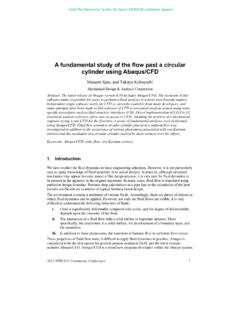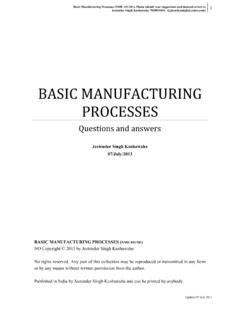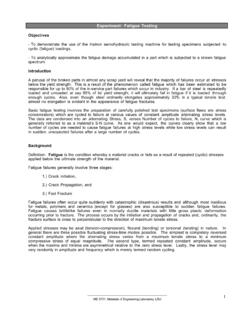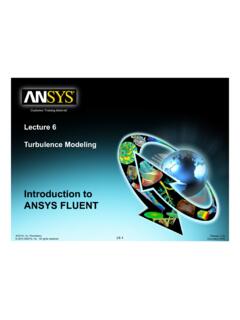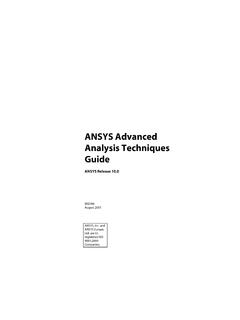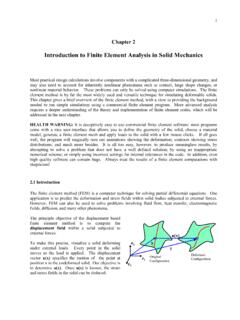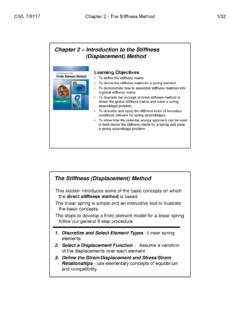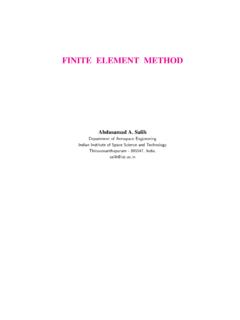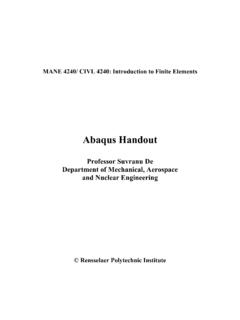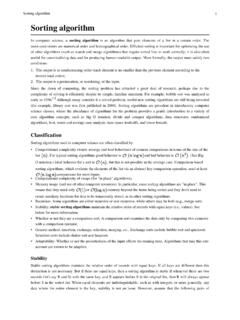Transcription of Lecture 6 Writing a UMAT or VUMAT - iMechanica
1 7/01 Writing User Subroutines with 6 Writing a UMAT or VUMATO verview Motivation Steps Required in Writing a UMAT or VUMAT UMAT Interface Examples VUMAT Interface Examples7/01 OverviewWriting User Subroutines with ABAQUS/Standard and ABAQUS/Explicit have interfaces that allowthe user to implement general constitutive equations. In ABAQUS/Standard the user-defined material model isimplemented in user subroutineUMAT. In ABAQUS/Explicit the user-defined material model isimplemented in user subroutineVUMAT. UseUMAT andVUMAT when none of the existing material modelsincluded in the ABAQUS material library accurately represents thebehavior of the material to be User Subroutines with These interfaces make it possible to define any (proprietary)constitutive model of arbitrary complexity.
2 User-defined material models can be used with any ABAQUS structural element type. Multiple user materials can be implemented in a singleUMATorVUMAT routine and can be used this Lecture the implementation of material models inUMAT orVUMAT will be discussed and illustrated with a number of User Subroutines with Proper testing of advanced constitutive models to simulateexperimental results often requires complex finite element models. Advanced structural elements Complex loading conditions Thermomechanical loading Contact and friction conditions Static and dynamic analysis7/01 MotivationWriting User Subroutines with Special analysis problems occur if the constitutive model simulatesmaterial instabilities and localization phenomena.
3 Special solution techniques are required for quasi-static analysis. Robust element formulations should be available. Explicit dynamic solution algorithms with robust, vectorizedcontact algorithms are desired. In addition, robust features are required to present and visualize theresults. Contour and path plots of state variables. X Y plots. Tabulated User Subroutines with The material model developer should be concerned only with thedevelopment of the material model and not the development andmaintenance of the FE software. Developments unrelated to material modeling Porting problems with new systems Long-term program maintenance of user-developed code7/01 MotivationWriting User Subroutines with Finite Element Modelling of the Damage Process in Ice, R.
4 F. McKenna, I. J. Jordaan, and J. Xiao, ABAQUS Users ConferenceProceedings, User Subroutines with The Numerical Simulation of Excavations in Deep Level Mining, M. F. Snyman, G. P. Mitchell, and J. B. Martin, ABAQUS Users Conference Proceedings, User Subroutines with Combined Micromechanical and Structural Finite Element Analysis ofLaminated Composites, R. M. HajAli, D. A. Pecknold, and M. , ABAQUS Users Conference Proceedings, User Subroutines with Deformation Processing of Metal Powders: Cold and Hot IsostaticPressing, R. M. Govindarajan and N. Aravas, private communication, User Subroutines with Macroscopic Shape Change and Evolution of CrystallographicTexture in Pre-textured FCC Metals, S.
5 R. Kalidindi and Anand, ActaMetallurgica, Required in Writing a UMAT or VUMATW riting User Subroutines with Required in Writing a UMAT or VUMAT Proper definition of the constitutive equation, which requires one of thefollowing: Explicit definition of stress (Cauchy stress for large-strainapplications) Definition of the stress rate only (in corotational framework) Furthermore, it is likely to require: Definition of dependence on time, temperature, or field variables Definition of internal state variables, either explicitly or in rateform7/01 Steps Required in Writing a UMAT or VUMATW riting User Subroutines with Transformation of the constitutive rate equation into an incrementalequation using a suitable integration procedure: Forward Euler (explicit integration) Backward Euler (implicit integration) Midpoint method7/01 Steps Required in Writing a UMAT or VUMATW riting User Subroutines with is the hard part!
6 Forward Euler (explicit) integration methods aresimple but have astability limit,,where is usually less than the elastic strain magnitude. For explicit integration the time increment must be controlled. For implicit or midpoint integration the algorithm is morecomplicated and often requires local iteration. However, there isusually no stability limit. An incremental expression for the internal state variables must alsobe obtained. stab< stab7/01 Steps Required in Writing a UMAT or VUMATW riting User Subroutines with Calculation of the (consistent) Jacobian (required forABAQUS/StandardUMAT only). For small-deformation problems ( , linear elasticity) orlarge-deformation problems with small volume changes ( , metalplasticity), the consistent Jacobian is,where is the increment in (Cauchy) stress and is theincrement in strain.
7 (In finite-strain problems, is anapproximation to the logarithmic strain.) This matrix may be nonsymmetric as a result of the constitutiveequation or integration procedure. The Jacobian is often approximated such that a loss of quadraticconvergence may ----------= 7/01 Steps Required in Writing a UMAT or VUMATW riting User Subroutines with It is easily calculated for forward integration methods (usually theelasticity matrix). If large deformations with large volume changes are considered( , pressure-dependent plasticity), the exact form of theconsistent Jacobianshould be used to ensure rapid convergence. Here, is thedeterminant of the deformation J () ------------------=J7/01 Steps Required in Writing a UMAT or VUMATW riting User Subroutines with Hyperelastic constitutive equations Total-form constitutive equations relating the Cauchy stressandthe deformation gradient are commonly used to model, forexample, rubber elasticity.
8 In this case, the consistent Jacobian is defined through::,where,is the material Jacobian, andis the virtualrate of deformation, defined as. F J ()JC= DJF=C D Dsym FF1 ()=7/01 Steps Required in Writing a UMAT or VUMATW riting User Subroutines with Coding theUMAT orVUMAT: Follow FORTRAN 77 or C conventions. Make sure that the code can be vectorized (forVUMAT only, to bediscussed later). Make sure that all variables are defined and initialized properly. Use ABAQUS utility routines as required. Assign enough storage space for state variables with the DEPVAR Required in Writing a UMAT or VUMATW riting User Subroutines with Verifying theUMAT orVUMAT with a small (one element) input Run tests with all displacements prescribed to verify theintegration algorithm for stresses and state variables.
9 Suggestedtests include: Uniaxial Uniaxial in oblique direction Uniaxial with finite rotation Finite shear2. Run similar tests with load prescribed to verify the accuracy of Compare test results with analytical solutions or standardABAQUS material models, if possible. If the above verification issuccessful, apply to more complicated InterfaceWriting User Subroutines with Interface These input lines act as the interface to aUMAT in which isotropichardening plasticity is defined.*MATERIAL, NAME=ISOPLAS*USER MATERIAL, CONSTANTS=8, (UNSYMM) , , , 0., , , , *DEPVAR13*INITIAL CONDITIONS, TYPE=SOLUTIONData line to specify initial solution-dependent variables*USER SUBROUTINES,(INPUT=file_name) The USER MATERIAL option is used to input material constants fortheUMAT.
10 The unsymmetric equation solution technique will be used ifthe UNSYMM parameter is InterfaceWriting User Subroutines with The DEPVAR option is used to allocate space at each material pointfor solution-dependent state variables (SDVs). The INITIAL CONDITIONS, TYPE=SOLUTION option is used toinitialize SDVs if they are starting at a nonzero value. Coding for theUMATis supplied in a separate file. TheUMATis invokedwith the ABAQUS execution procedure, as follows:abaqus job=.. user=.. The user subroutine must be invoked in a restarted analysisbecause user subroutines are not saved on the restart InterfaceWriting User Subroutines with Additional notes: If a constant material Jacobian is used and no other nonlinearity ispresent, reassembly can be avoided by invoking the quasi-Newtonmethod with the input line*SOLUTION TECHNIQUE, REFORM KERNEL=n nis the number of iterations done without reassembly.


